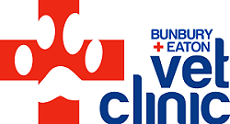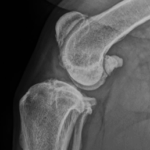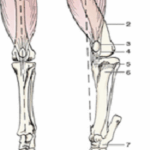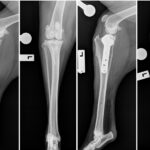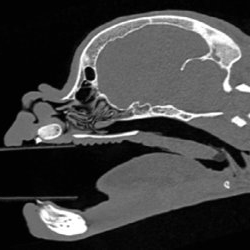
CT of a French Bulldog Head
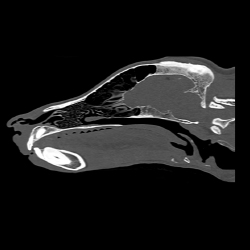
CT of a Labrador Skull for comparison
Over the last few years, we have noticed an increased number of brachycephalic dogs such as French Bulldogs and Australian Bulldogs attending our clinic. They are such happy, beautiful characters that it’s easy to understand why people buy them. Their big eyes and happy outlook will brighten anyone’s day.
However, we are seeing a lot of these dogs with severe breathing issues, which often needs surgery to improve their quality of life. This condition is called Brachycephalic Obstructive Airway Disease (BOAS).
We’ve all seen videos on Facebook of these dogs falling asleep while they’re sitting up, or resting their heads on a cushion to sleep. Our natural instinct is to say “aw, isn’t that cute”. The sad reality is these dogs are falling asleep like that because they struggle to breathe while laying down.
If we look at the skulls of these dogs and compare a CT of a French Bulldog and a Labrador, we can see there is a massive difference in the airway. These differences, including the narrows nostrils, long soft-palate, large tonsils, and compressed structures in the nasal passages all contribute to breathing problems.
How to recognise a problem with your own dog.
A few weeks ago, I was sitting in the office doing some paperwork and I could hear a dog’s raspy breathing in the waiting room. I rushed out in case it was an emergency, but this wasn’t a new problem for the dog – it always breathed like that. The owners said “it’s normal for him”, and didn’t think anything was abnormal.
The first thing to realise with these dogs is we shouldn’t just say “it’s normal for the breed”. It may be common for the breed, but breathing problems shouldn’t just be accepted as normal, and they do need to be addressed. Struggling to breathe every day of their life, not being able to do normal exercise, vomiting almost daily, and not being able to sleep in a normal manner shouldn’t be explained away by “but he’s a Frenchie, that’s what they do”.
If your dog snores, pants heavily with mild exercise, or overheats easily, we recommend having them assessed. I find a good test for exercise in these breeds is to walk around a footy oval. Your dog should be able to walk around a footy oval comfortably in 10 minutes without overheating or struggling to breathe. Now is a great chance to do this test, before the heat of summer arrives, so consider performing this test this weekend.
Overheating in Brachycephalic dogs.
Every summer, we are seeing more and more brachycephalic dogs overheating. These dogs are coming to us after just being left in the backyard. A “normal” dog would have been fine in that environment, but for some of these dogs, it was nearly fatal.
Brachycephalic dogs can struggle in the heat for several reasons. Because they rely on panting to cool, their shorter mouths are much less effective as there is a smaller surface area for heat exchange. Their long soft palate is an even bigger issue. The soft palate should normally end well clear of the larynx, but in affected dogs, it can reach the opening of the larynx (and I’ve even seen them long enough to reach into the trachea. When the dog starts to pant, the soft palate gets sucked into the larynx, which stops them being able to breathe and pant effectively. The panting process in dogs needs a lot of muscle movement, which creates its own body heat. This means that as the dog tries to pant (but can’t pant effectively), it tries harder to pant to get rid of this extra heat being created. This creates even more body heat, more drive to pant, and a vicious and fatal cycle commences. We have seen dogs with body temperatures as high as 44 degrees from this problem (normally their temperature should be below 39 degrees), and it is very hard to save their life at that point. To save the pet at this point, we need to anaesthetise them, cool them down, and possibly perform emergency surgery on their airway to allow them to breathe more normally when they wake up.
What should I do with my brachycephalic dog?
BOAS tends to be a progressive disease if left untreated. It is critical to address this problem while the dog is still young. Without treatment, secondary changes such as laryngeal collapse, ventricle eversion, and thickening of throat structures will occur. These changes are generally occurring by three years of age, and they cannot be reversed once they occur.
Although we cannot give these dogs a “normal” airway, we can do a lot to improve their breathing. These dogs will generally need their soft palate shortened, their nose opened, and possibly their tonsils and laryngeal saccules removed. In some cases, surgical thinning of the soft palate may also be required.
The best time to address this problem is around 9-12 months of age, though severely affected dogs may need surgical treatment earlier.
Depending on the case, we may be able to do the surgery at the Eaton Vet Clinic, though with severely affected and older dogs it is often recommended to have surgery at a facility where there is 24 hour aftercare as some complications can be seen following the surgery. Surgery can sometimes be done at the same time as surgical desexing to minimise the number of anaesthetics needed for the dog.
If you would like to discuss your pets breathing or airway surgery, please book an appointment with Dr Braden Collins at the Eaton Vet Clinic, who has a passion for helping these beautiful dogs live the best life they can.
